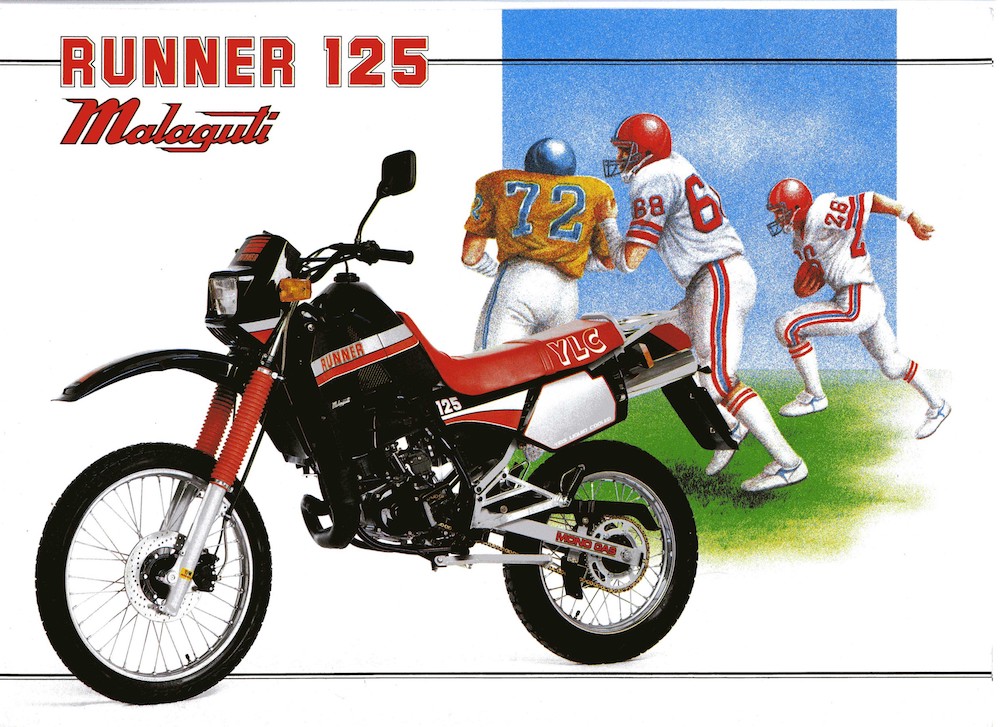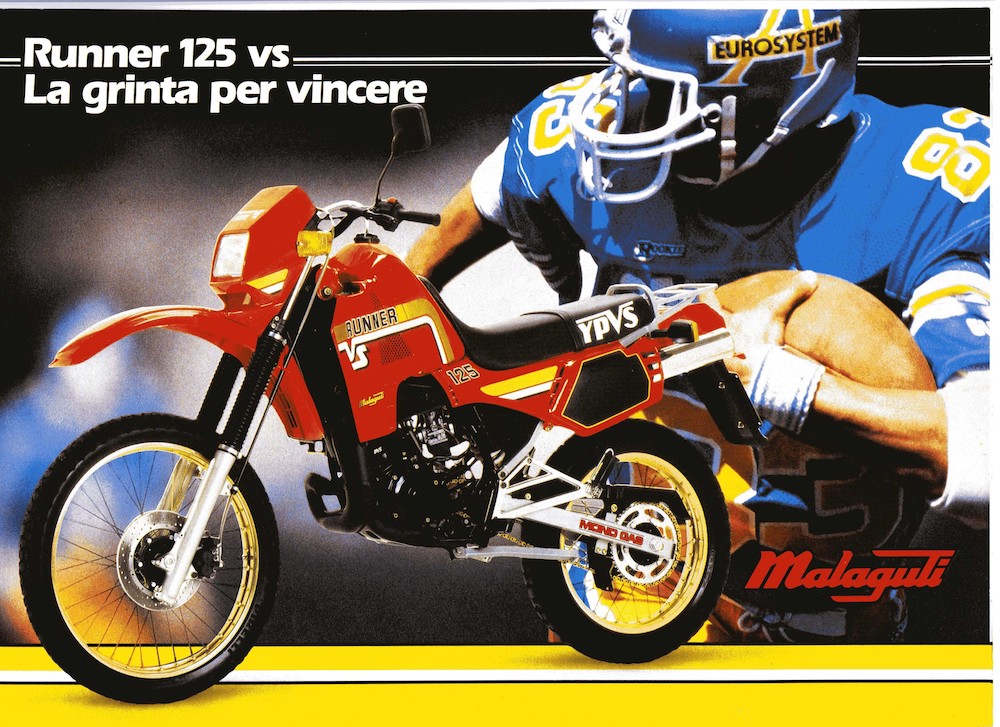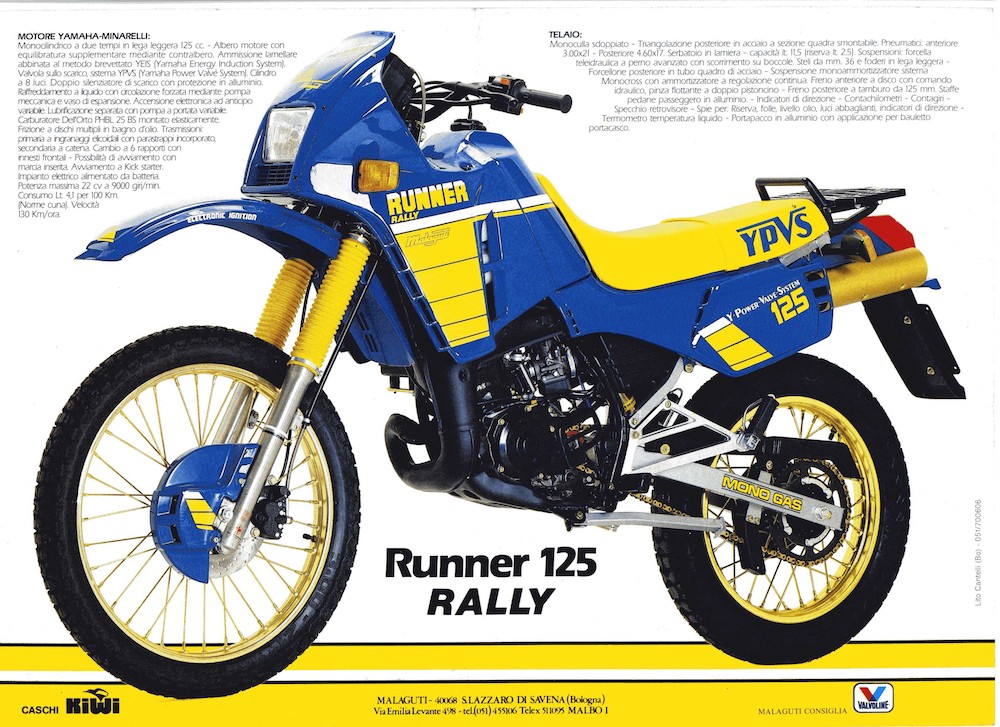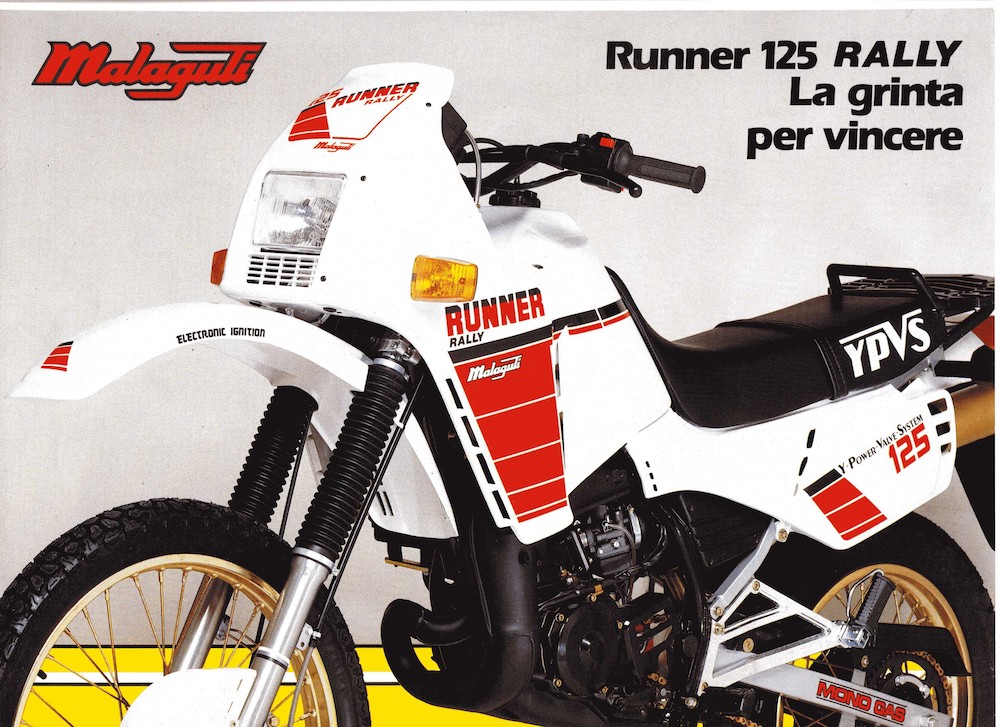Ringraziamo Francesco Lombardo per il suo contributo fondamentale nello scrivere questo articolo dedicato all’unica moto 125cc anni 80 prodotta da Malaguti.
La Runner 125 venne prodotta dal 1985 al 1986. All’epoca la Malaguti produceva soltanto moto di 50cc ed era leader nella vendita di tuboni e quindi, decise di entrare nel segmento delle 125 che in quegli anni era in notevole crescita, raggiungendo un accordo commerciale con la Minarelli. Quest’ultima produceva già, con specifiche Yamaha, un motore destinato alla enduro Yamaha DT 125, quindi si giunse ad un accordo tra Malaguti, Minarelli e Yamaha.
Questa enduro denominata YLC (Yamaha Liquid Cooled) per via del modello del motore e della scritta sulla sella, montava un sofisticato monocilindrico due tempi raffreddato a liquido a sei rapporti – identico all’unità montata sulla Yamaha DT 125 – con sistema di immissione lamellare YEIS (Yamaha Energy Induction System), miscelatore automatico e carburatore Dell’orto PHBL 25 BS che sviluppava la potenza di 17 Cv a 7500 giri e poteva spingerla ad oltre 120 orari. Peccato solo per la mancanza dell’avviamento elettrico, considerato superfluo su una enduro, ma comunque pur sempre una dotazione tecnica di sicuro richiamo per i giovani.
La caratteristica che la distingueva tra le enduro dell’epoca era senza dubbio il doppio silenziatore di scarico, unico tra le enduro 125.
La moto costava 3.300.000 lire ed esteticamente era simile ai 50cc MFX o MGX o MDX, il telaio e molta componentistica erano uguali a quelli dei modelli enduro 50, ma variavano:
1) il telaietto posteriore progettato per avere gli attacchi delle pedane passeggero;
2) la sella più lunga per ospitare il passeggero;
3) i fianchetti laterali;
4) l’ammortizzatore posteriore.
Il serbatoio aveva un’autonomia di 11,5 litri di cui riserva 2,5. Le colorazioni disponibili erano: nera con adesivi rossi e grigi e sella rossa; bianca e rossa con adesivi blu e neri e sella rossa; successivamente ne venne introdotta un’altra bianca con adesivi blu e sella blu.
La strumentazione era completa, con illuminazione color ambra composta da: tachimetro, contachilometri, contagiri, spia folle, benzina, olio, luci abbaglianti, frecce ed un indicatore della temperatura formato da più luci colorate. Molto belli i blocchetti elettrici costruiti dalla Cev.
La Forcella anteriore era teleidraulica a perno avanzato con scorrimento su boccole e steli da 36 mm, con foderi in lega leggera, al posteriore il classico forcellone in tubi quadri in acciaio con sospensione mono Cross a regolazione continua. L’impianto frenante vedeva all’ anteriore un disco da 230 mm servito da pinza a doppio pistoncino ed al posteriore un classico tamburo da 125 mm. Le ruote erano all’ anteriore 3,00×21 ed al posteriore 4,60×17. Il peso dichiarato era di 120 kg.
1986: RUNNER VS
Nei primi mesi del 1986 la tecnologia sui due tempi si evolse e Yamaha che aveva enorme esperienza nel mondo delle corse, deteneva un brevetto già dal 1983, che era la valvola parzializzatrice della luce di scarico YPVS, ovvero Yamaha Power Valve System. Yamaha aggiorna i suoi motori 125 equipaggiandoli con questo tipo di valvola e di conseguenza anche la Malaguti aggiornava la Runner con il nuovo motore. È bene notare che la Yamaha fu la prima 125 ad adottare un sistema con valvola comandata da servomotore elettrico a controllo elettronico, anticipando la concorrenza di due anni, ferma alla valvola a comando meccanico o pneumatico per Aprilia. Questa particolarità fece della Runner Vs non solo una moto tecnologicamente all’avanguardia ma anche (insieme alla cugina DT 125) la progenitrice, dei motori 125 con valvola allo scarico. Con questa innovazione il cilindro poteva adottare un diagramma di distribuzione più spinto, pur mantenendo una migliorata sfruttabilita’ ai bassi e medi regimi quando la valvola appunto era chiusa parzializzando i gas di scarico. La casa dichiarava 22 Cv a 9000 giri ed una velocità di punta di 130 km/h, prestazioni al top per quei tempi.
La moto venne proposta a 3.554.000 lire, esteticamente simile ad un Mdx gold e le colorazioni proposte erano: nera con adesivi rossi ed oro e sella rossa oppure rossa con adesivi neri ed oro e sella nera. Purtroppo, la Malaguti rimase sprovvista del sempre più apprezzato avviamento elettrico.
Le principali modifiche rispetto alla versione precedente sono:
1) nuova mascherina porta faro;
2) aggiunta del contachilometri parziale;
3) tachimetro e contagiri rivisti nella grafica;
4) scritta YPVS sulla sella;
5) nuovo motore;
6) specchietti retrovisori Vitaloni Scimitar.
Per il resto non vi erano variazioni rispetto al modello precedente. Questa versione resterà in commercio fino a metà del 1987.
1987: Runner Rally
A Marzo del 1987 la Malaguti aggiorna la Runner, ma, a differenza della precedente versione Vs che montava un nuovo motore, quindi una versione totalmente inedita, questa versione riceve soltanto degli aggiornamenti estetici. Il nome diventa Runner Rally e sarà affiancata dalla Vs per alcuni mesi, venne venduta a 3.954.000 lire, esteticamente simile ad una Dune prima serie.
Più che un aggiornamento vero e proprio si può pensare ad un’operazione fatta, in un certo senso per “riciclare” le carenature del modello Dune, ancora gradevoli come linea e design.
Le colorazioni disponibili erano: nera con adesivi gialli e bianchi e sella gialla, blu con adesivi gialli e bianchi e sella gialla, bianca con adesivi rossi e neri e sella nera, rossa con adesivi bianchi e blu e sella blu.
Le principali differenze rispetto alla Vs, oltre alle carenature anteriori, sono:
1) portapacchi con predisposizione per bauletto porta casco;
2) segnalatore della temperatura del liquido refrigerante con una grafica simile a dei led colorati;
4) terminali di scarico color oro;
5) copridisco anteriore;
6) diversi attacchi della ruota anteriore alla forcella.
Questa versione venderà un discreto numero di esemplari e rimarrà in commercio fino alla fine del 1988, poi verrà aggiornata con un parafango anteriore basso come la 50 Mrx, ma, per il resto identica alla precedente. Resterà in produzione fino alla fine del 1989, ma in commercio fino ai primi mesi del 1990, quando Malaguti si ritirerà definitivamente dal settore delle 125.
È da notare come nell’anno di uscita dal mercato la Runner fosse obsoleta come telaio, ciclistica e design ma ancora con un motore tecnologicamente più che valido, questo dimostra quanto innovativo fosse nel 1986 il motore Yamaha provvisto di sistema YEIS ed YPVS.




